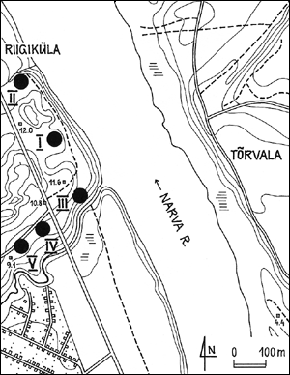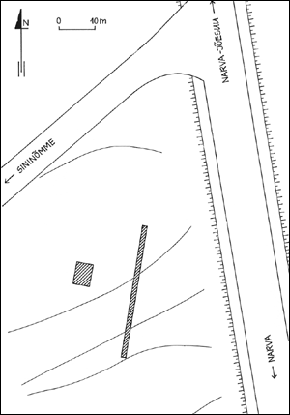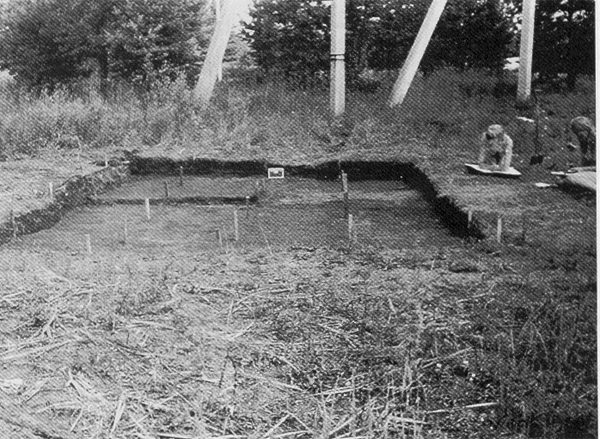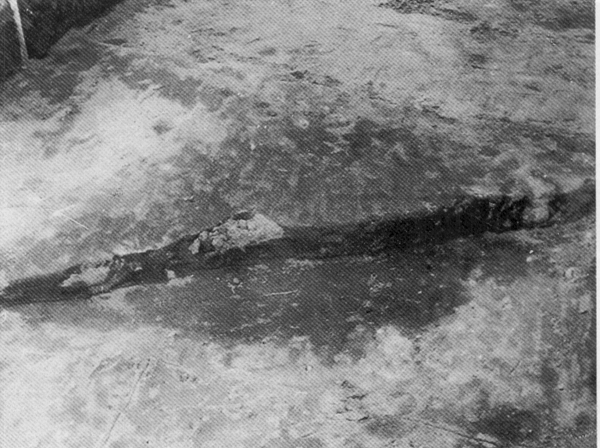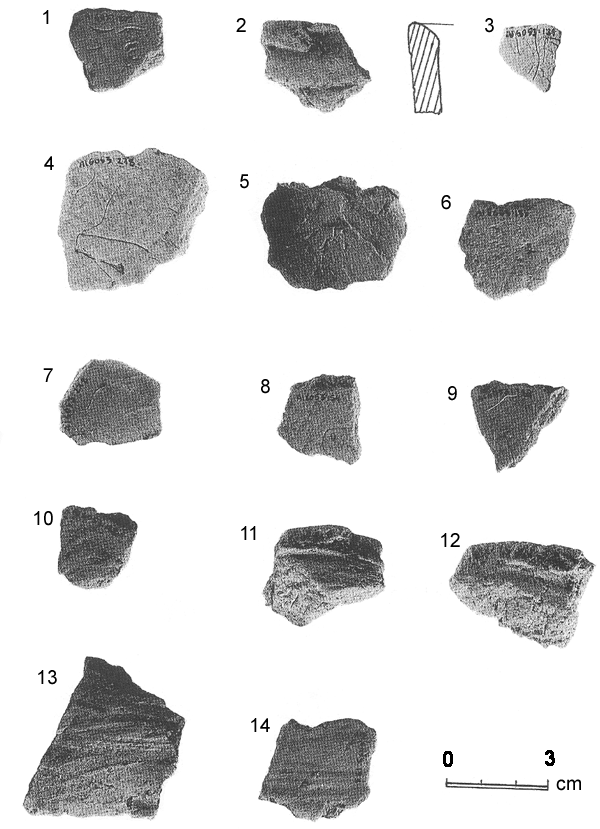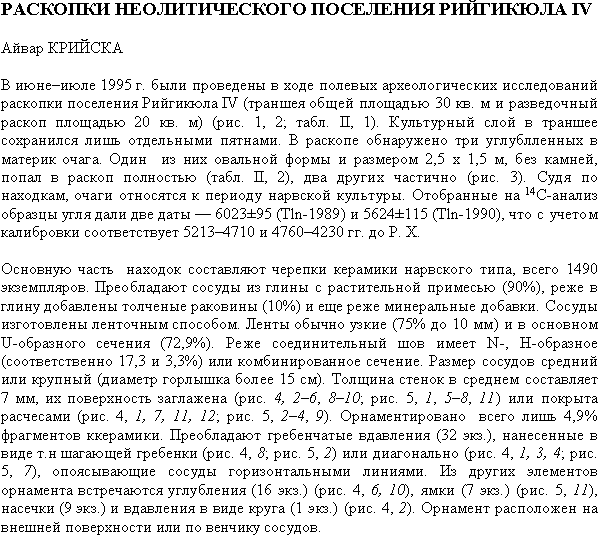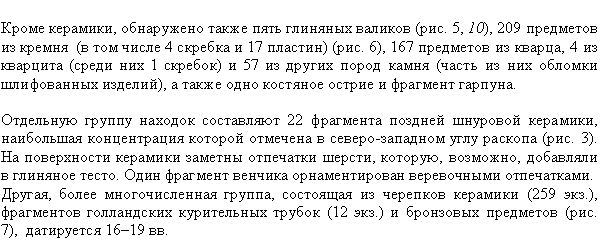ARCHAEOLOGICAL EXCAVATIONS ON THE NEOLITHIC SITE
OF RIIGIKÜLA IV
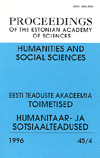
Aivar KRIISKA Tartu Ülikool
(University of Tartu), Lossi 3, EE-2400 Tartu, Eesti (Estonia).
Published: Proceedings of the Estonian Academy of Sciences. Humanities
and Social Sciences, 45:4, 1996, 410–419.
In June and July 1995,
archaeological field work was carried out at Riigiküla, on the lower reaches
of the Narva River. The settlement site of Riigiküla IV (Fig. 1) was excavated
within the framework of this project (the description of the area and location
of the sites see: Gurina, 1967; Kriiska, 1995a, 1995b)1.
The excavations were financed by PACT and the University of Tartu, the
extensive phosphate reconnaissance by the Central Board of Antiquities
of Estonia. The excavations were carried out as part of practical training
for students of archaeology of the University of Tartu.
A trench and an excavation were
dug, measuring respectively 30 and 20 m² (Figs. 2, 3; Plate II, 1). The
soil was screened. In the trench the cultural layer had preserved only
in small spots. The 10–50 cm thick ploughlayer yielded numerous
finds. In the excavation the cultural layer was preserved under the 15–50
cm thick ploughlayer. Three fire pits deepened 25–40 cm into the
ground could be distinguished by black and coaly soil in the excavation.
Two of them were almost stoneless, one contained a few stones (Fig. 3).
One of the fire pits, measuring 2.5–1.5 m, was completely excavated
(Fig. 3; Plate II, 2), two others remained partly out of the excavation.
The finds were mostly concentrated around the fire pits. Some coaly soil
occurred also between the fire pits.
The find material consists predominantly
of pottery of Narva type, 1490 sherds altogether. Judging by the rim sherds
these come from more than 30 pots.2 The
clay of the sherds carries traces of some organic admixture (1477 sherds).
Nearly 90% of the potsherds had contained some plant admixture, which has
burnt out. In about 10% of the sherds, cockleshell rubble is traceable,
often together with plant admixture. Thirteen sherds contain a considerable
amount of mineral admixture: in five cases only stone rubble, in one case
sand, six sherds contain sand with plant admixture, and one stone rubble
with plant admixture. The other indicators (band technique, the shape of
the connecting surfaces of the bands, etc.) link these sherds with a mineral
content to the Narva type. The finding conditions also confirmed this. 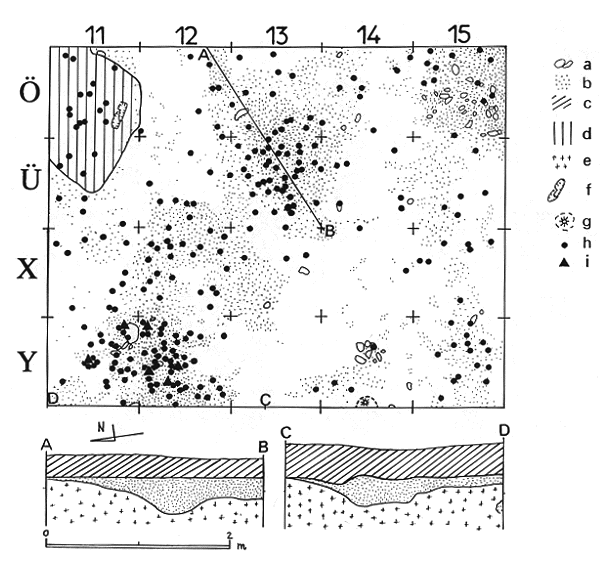
Fig. 3. Riigiküla IV. The general plan of the excavation. a stones, b coaly black surface, c ploughlayer on profile drawings, d shell-carter, e sand on profile drawing, f shell fragments, g stabilizer of the trench-mortar mine, h Neolithic finds, i Late Corded Ware. The vessels have been moulded
in band technique except the bottom, which has been pressed of a single clay
lump. The majority of the bands have U-shaped connecting surfaces (Fig.
4, 3, 7, 9; Fig. 5, 9). Also N, H, or combined
shapes occur (on the connecting techniques see Kriiska, 1995b). Of the
369 bands that have a determinable connecting surface, 269 (72.9%) are
of U type, 64 (17.3%) of N type, 12 (3.3%) of H type, 16 (4.3%) of N/U
type, and 8 (2.2%) of H/U type. Both connecting surfaces had preserved
in 196 bands, so their width could be measured. The bands are 3–35
mm wide. The width of 148 bands (75.5%) is less than 10 mm. The wider bands
belong mostly to the N type. More than 90% of the 1.5 cm wide bands have
N- or N/U-type connecting surfaces.
The sherds found are too fragmentary
to yield enough information about the size and shape of the vessels. The
four bottom or near-bottom sherds indicate a conical bottom. Among the
sherds there is also a fragment of a bottom tip3.
As the size of the vessels and the thickness of the walls is usually proportional
in Estonian Neolithic pottery, it seems that here we have mostly medium-sized
and big vessels. This is confirmed also by the small convexity of the sherds.
The diameters of the orifice calculated on the basis of four brim sherds
have been 11.2 cm (AI 6053:131), 15.1 cm (AI 6053:230), 15.8 cm (AI 6053:290),
and 15.9 cm (AI 6053:242). Thirty-eight brim sherds were found, five of
them belonging to the same vessel. Most of the brims are tapering compared
to the sides, thirteen resemble the band with a U-shaped connecting surface
(Fig. 4, 11), two are tapering from outside and twenty-three
from inside (Fig. 4, 10, 12; Fig. 5, 2). Of the
last group eight are also slightly curving outwards (Fig. 4, 12;
Fig. 5, 2). The thinning inner surface is often ornamented.
Both surfaces had preserved well
enough in case of 557 sherds to enable the measuring of their maximum thickness.
It was from 3 to 14 mm, mostly below 10 mm, on the average 7 mm.
The surfaces of the sherds are smoothed
(Fig. 4, 2–6, 8–10; Fig. 5,
1, 5–8, 11) or striated
(Fig. 4, 1; 7, 11, 12;
Fig. 5, 2–4, 9). A total of 981 sherds
(82.2%) have a smoothed surface and 216 sherds (17.8%) a striated surface,
but 626 sherds of these have one of their surfaces crumbled. There inner
surface is striated more often (133) than the outer surface (44) or both
surfaces (39). Mostly the striae are clear and strongly pressed into the
surface. There are some sherds with a very carefully smoothed surface that
has been even slightly polished.4 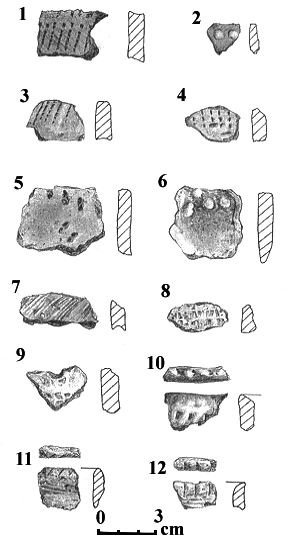
Fig. 4. Pottery of Narva type from the Riigiküla IV site (AI 6053: 127, 44, 267, 143, 74, 60, 59, 103, 413, 198, 245, 139). The number of ornamented
potsherds is small, only 73 (4.9%). The ornament has probably been on the sides or
on the upper part of the sides and on the brim; in the latter case usually
on its thinning inner surface. Among decorative elements there are comb
impressions, hollows, pits, notches, grooves, and circle impressions.
Comb impressions occur on 39 sherds.
In 32 cases they are on the outer surface of the wall and in 9 cases on
the brim; among the latter, 2 sherds have been ornamented with comb impressions
both on the edge and the side wall. Mostly it was not possible to measure
the length of the impressions but all comb impressions on the edge and
on the side walls of five sherds are short – less than 25 mm (Fig.
4, 1, 12; Fig. 5, 2). Comb impressions
are about 0.5–4 mm, mostly 1–2 mm wide. In two cases
the impression is curved. On 27 sherds it was possible to determine ornamentation
motives more precisely. In 14 cases the motive was the so-called stepping
comb (Fig. 4, 8; Fig. 5, 1), which on two sherds
of the same vessel was combined with short two-teeth comb impression under
the brim on the outer wall and on the inner surface, on the thinning part
of the rim. In twelve cases the diagonal comb impressions were situated
in a horizontal belt (Fig. 4, 1; 3; 4;
Fig. 5, 7) and in one case the vertical comb impressions were
in a horizontal belt. 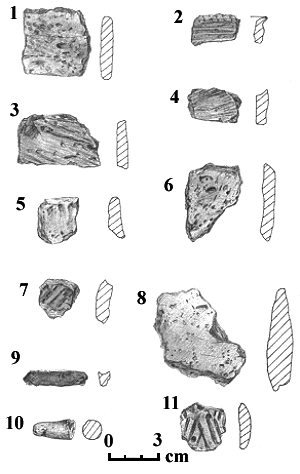
Fig. 5. Pottery of Narva type from the Riigiküla IV site (AI 6053:244, 357, 459, 458, 253, 363, 289, 91, 411, 138, 230). Hollows, i.e. impressions less
deep than half the wall thickness, are found on sixteen sherds, in fifteen cases
the hollows are on the side wall, in two cases they are on the edge, among
these in one case the hollows are both on the edge and on the outer surface
(Fig. 4, 10). One sherd has hollows combined with notches.
Hollows are usually small (diameter below 5 mm), except in three cases.
They are round, diamond- or segment-shaped, often irregular and only slightly
pressed into the surface. With seven sherds it was possible to determine
the ornamentation motive: in five cases the hollows were situated in a
horizontal line (Fig. 4, 6; 10) and in two cases
in a diagonal line.
PLATE II
PLATE III
Pits, i.e. impressions with a depth of half the wall thickness or more, are found on the outer surfaces of seven sherds, in one case combined with grooves (Fig. 5, 11). Notches are mainly oblong and possibly some of them have been made with a finger-nail. In one case, as mentioned before, they occur together with hollows. In one case the notches were in a diagonal line. There are grooves on four sherds (one with pits), in three cases on the side wall and in one case on the edge (Fig. 4, 11). In one case the grooves were in a diagonal line. One sherd has a 5-mm circular impression on it (Fig. 4, 2). One sherd has a hole drilled through after the baking (Fig. 4, 9). Similar holes can be also seen in pottery of Narva type found elsewhere (Kriiska, 1995a, p. 105). One of the potsherds found at Riigiküla IV is unique. According to the conditions of discovery it belongs undoubtedly to the layer of Narva culture, but it contains mineral admixture and it has been ornamented with a net design of long grooves, combined with small round pits (Fig. 5, 11). The grooves have been made after the pits. No analogues have been found to this sherd elsewhere on the lower reaches of the Narva River. It is possible that the pot has been brought there from somewhere else, maybe even from beyond the area of the Narva culture. Judging by the sooty layer on the surfaces of some potsherds, the pottery of Narva type, at least part of it, has also been used for cooking.5 In addition to potsherds, five clay bars were found (Fig. 5, 10), which are characteristic also of other sites of the Narva culture (Kriiska, 1995a, p. 74). Their composition is analogous to the pots and probably they are the leftover from making the pots, to be more exact, from the pieces of the rolled clay used for moulding the band. (Kriiska, 1995a, pp. 74–75). However, other interpretations have also been presented (Gurina, 1955, p. 168, 1967, p. 40). 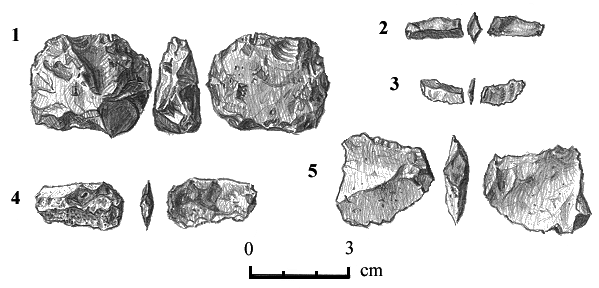
Fig. 6. Flintstone scraper (1), blades (2, 3), and blade-like flakes (4, 5) from the Riigiküla IV site (AI 653:129, 112, 173, 78, 427). Evidently the major part of the flint and quartz finds also belong to the same period. A total of 209 flintstone artefacts were found. The flintstone is of varying quality and colour; mostly purple and greyish. No traces of secondary processing were observed on 154 flakes of flintstone, including 33 blade-like flakes (Fig. 6, 4, 5). There are 17 blades or their fragments (Fig. 6, 2, 3). Amongst the artefacts with secondary processing there are only four scrapers (Fig. 6, 1). The blades are up to 2.8 cm long and mainly with one ridge. Among the scrapers there are two side and two end scrapers. They are made of flakes (two) or blades (two) of 1.2–3.5 cm length. The edges are mostly narrow (five) and convex (five) or concave (three). A total of 167 quartz and 4 quartzite artefacts were found. Of these 164 were quartz flakes and 2 quartzite flakes, 2 were quartz blades and 1 was a quartzite blade. In addition, there was one blade-like flake of quartz and a quartzite scraper. The scraper is trapezoid and with a wide straight edge. The finds of other rocks number 57; of these 45 are stone flakes, 3 are flake-like blades, 6 sandstone fragments, one of which is a fragment of a polishing stone. Three fragments of polished stone artefacts were found. Two smaller fragments can belong to wedges, and one is part of a polished stone stick. The only bone artefacts are a 8 cm point with a slanting corner blade and a fragment of a harpoon.6 The 14C analyses of the charcoal gathered from the fire pit in the
squares X–Y/11–12
gave the result 5624±115 BP (Tln-1990), which with a 95% probability
corresponds to 4760–4230 BC (cal.). The coal gathered in the cultural
layer of the western part of the excavation was dated 6023±95
BP (Tln-1989), corresponding 5213–4710 BC (cal.).
Sherds of other types of Neolithic
pottery were found as well. There is reason to connect two sherds with
Typical and three with Late Comb Ware. However, these sherds are very small,
they yield little information, and are not typical, so they can be classified
only speculatively. A clearer and bigger group is formed of 22 potsherds
of the Late Corded Ware. Nineteen of these were found in the excavation,
three in the trench. Most of the sherds were found in the ploughlayer and
some in the upper part of the cultural layer. A bigger concentration could
be noted in the northwestern part of the excavation, where the sherds were
found in the cultural layer (Fig. 3). There seem to be fragments of only
three or four pots.
In the composition of Late Corded
Ware an important feature is the absence of the mineral admixture; only
single, probably occasional mineral grains can be seen. The porosity of
sherds indicates a sort of organic admixture that has burned out. On the
broken surfaces very small round holes can be seen. There are many sharp
impression traces on the surfaces, these may originate from hairs. Both
these phenomena suggest that hairs have been mixed with clay. I have assumed
it already earlier, in the case of Narva Joaoru Late Corded Ware (Kriiska,
1994, p. 48). A similar phenomenon is represented also in Finnish so-called
Imitated Textile-Impressed Pottery (Carpelan 1970, p. 27; Arponen, 1994,
p. 11).
It was possible to measure the wall
thickness of 13 sherds. It varies from 7 to 11 mm, nearly a half of the
walls were 10 mm thick. The pots have been big with straight walls. The
two bottom fragments found there indicate a flat bottom, with a convex
transition from bottom to side. One brim fragment is unprofiled, as thick
as the side wall and the upper part of the rim is slanting inside.
The surfaces of the pots are smoothed
or striated. Out of thirteen sherds with both preserved surfaces, eight
are smoothed on both sides, three striated, and two sherds have a striated
and smoothed outside. Among the fragments that have one preserved surface
there are eight sherds with smoothed outer side and one with striated outer
side. Of the sherds with two preserved surfaces nine have hair impressions
on both sides (Plate III, 1–12), two sherds have
hair impressions only on the outer side, and two have no clear impressions.
Among the sherds with one preserved surface there are seven with hair impressions
and only one is without. Such impressions are characteristic also of the
Late Corded Ware found in other parts of Estonia (Kriiska, 1994, p. 49).
Decoration could be traced only on
one sherd, on a brim fragment (Plate III, 2). There are two
horizontal impressions 9 mm below the edge at a distance of 10 mm. The
upper one is groove-like in the preserved part but the lower one is a clear
cord impression. The upper one was probably made with a cord, too. Originally
the impressions surrounded the perimeter of the pot.
The same site has yielded considerably
later finds as well. Six hand-moulded Iron Age potsherds were found, of
which two sherds with striated surfaces may date from the Pre-Roman Iron
Age (Plate III, 13, 14). The other and considerably
bigger group of finds belongs to the 16th–19th centuries. Also
93 unglazed and 116 glazed sherds of wheel pottery, 3 stoneware, and 47
faience sherds date back to the same period. Twelve pipe fragments of kaolin
clay were found, too, among them three from a bowl part. One bone and one
glass fragment were found. Of the metal objects, a presumable buckle fragment
(Fig. 7, 1), a thin ribbon of bronze sheet (Fig. 7, 2),
a bronze plaque (Fig. 7, 3), a silver button base, and some
nails can be connected with that settlement period. All those objects were
found in the mixed layer. Fig. 7. Bronze finds from the Riigiküla IV site: 1 buckle fragment, 2 ribbon of bronze sheet, 3 bronze plaque (AI 653: 130, 171, 121) __________
REFERENCES Arponen, A.
1994. Rahajärvi – lisää imitoidusta tekstiilikeramiikasta.
— Kentältä poimittua 2. Kirjoitelmia arkeologian alalta.
Helsinki, 9–16.
Carpelan, C. 1970. Ns. imitoitua tekstiilikeramiikkaa Suomessa.
— Suomen Museo. Helsinki, 23–33.
Kriiska, A.
1994. Narva jõe alamjooksu ala neoliitiline keraamika. MA dissertation.
University of Tartu.
Kriiska, A.
1995a. Narva jõe alamjooksu ala neoliitiline keraamika. — Muinasaja teadus, 3.
Eesti arheoloogia historiograafilisi, teoreetilisi
ja kultuuriajaloolisi aspekte. Tallinn, 54–115.
Kriiska, A.
1995b. New Neolithic settlements in Riigiküla. — Proc. Estonian
Acad. Sci. Humanities and Social Sciences, 44, 4,
448–454.
ARHEOLOOGILISED VÄLJAKAEVAMISED RIIGIKÜLA IV NEOLIITILISEL ASULAKOHAL Aivar KRIISKA 1995. aastal tehti
arheoloogilisi kaevamisi Riigiküla
IV asulakohal (tranšee 30 m² ja proovikaevand
20 m²; joon. 1, 2; tahv. II, 1). Tranees oli kultuurkihti säilinud
ainult laiguti. Proovikaevandist leiti kolm maapinda süvendatud tuleaset.
Neist üks, ovaalse kujuga 2,5 x 1,5 m suurune kivideta kolle jäi
kaevandisse kogu ulatuses (tahv. II, 2), teised kaks ainult osaliselt (joon.
3). Tuleasemed, nii nagu enamus leiuainesestki, kuuluvad Narva kultuuri
perioodi. Proovikaevandist kogutud söest saadi kaks 14C-dateeringut
– 6023±95 (Tln-1989) ja 5624±115 (Tln-1990),
mis kalibreeritult vastavad aastatele 5213–4710 e.Kr. ja 4760–4230
e.Kr.
Leidude põhiosa (kokku 1490)
on Narva tüüpi keraamika killud. Enamasti (u. 90%) on nõud
valmistatud taimse massiga segatud savist. Harvem (u. 10%) on savisse lisatud
teokarbipurdu. Üksikud killud on mineraalse lisandiga. Nõud
on vormitud linttehnikas. Lindid on kitsad (75% ainult kuni 10 mm) ja põhiliselt
U-tüüpi ühenduspinnaga (72,9%). Vähem on N- (17,3%),
H- (3,3%) või kombineeritud ühenduspindadega linte. Savinõud
on olnud keskmise- või suuremõõdulised (suuava läbimõõt
üle 15 cm). Leitud kildude seinapaksus on keskmiselt 7 mm. Pinnad
on silutud (joon. 4, 2–6, 8–10;
joon. 5, 1, 5–8, 11) või
riibitud (joon. 4, 1, 7, 11, 12;
joon. 5, 2–4, 9). Ornamenti esineb vaid
4,9% kildudel. Rohkem kohtab kammivajutisi (32 kildu) nn sammuva kammi
motiiviga (joon. 4, 8; joon. 5, 2) või
paiknevad kaldsed kammijäljendid horisontaalvöönditena (joon.
4, 1, 3, 4; joon. 5, 7).
Teistest ornamendielementidest esineb lohundeid (16; joon. 4, 6,
10), lohke (7; joon. 5, 11), täkkeid (9)
ja sõõrvajutisi (1; joon. 4, 2). Ornament paikneb
välispinnal või serval.
Leiumaterjali hulgas oli veel 5 savikangikest
(joon. 5, 10), 209 tulekivi- (sh. 4 kõõvitsat
ja 17 laastu; joon. 6), 167 kvartsi- ja 4 kvartsiidi- (sh. 1 kõõvits),
57 teistest kivimitest leidu (osa neist lihvitud kiviesemete fragmendid),
1 luust teravik ja harpuuni fragment.
Omaette leiurühmad moodustavad
22 hilise nöörkeraamika kildu, mille leiutihedus oli suurem proovikaevandi
loodenurgas (joon. 3). Kildude pindadel esineb karvajäljendeid. Võimalik,
et karvu on segatud savimassi. Üks servatükk on ornamenteeritud
nöörivajutistega.
Teine ja märksa suurem leiurühm,
mis sisaldab keraamiliste nõude kilde (259), kaoliinsavist piipude
fragmente (12) ning pronksesemeid ja nende fragmente (joon. 7), on dateeritav
ilmselt 16.–19. sajandisse.
|
